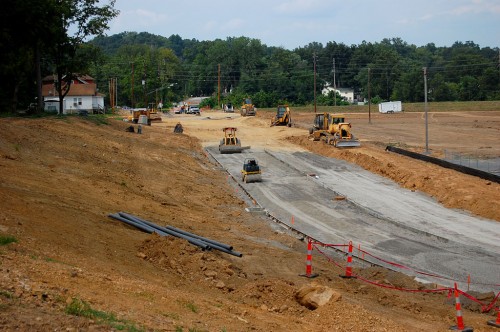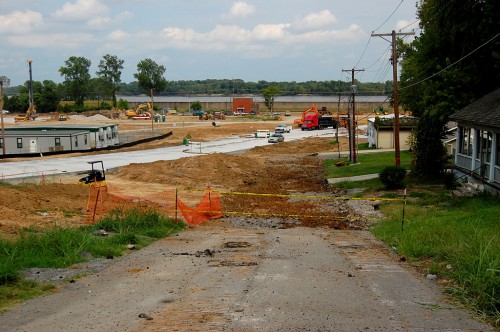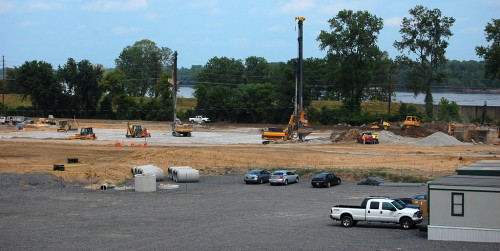 Main Street used to have a slight jog around the old shoe factory, then go through a set of flood gates to cross Sloan Creek and head north through Red Star. To accommodate the new Isle Casino Cape Girardeau, Main Street was curved more to the north to tie directly into Chestnut Street / 177 / Big Bend Road. It looks like it’s going to cross the creek far enough west that it won’t need flood gates. A construction worker said he thought the old gates might be permanently closed.
Main Street used to have a slight jog around the old shoe factory, then go through a set of flood gates to cross Sloan Creek and head north through Red Star. To accommodate the new Isle Casino Cape Girardeau, Main Street was curved more to the north to tie directly into Chestnut Street / 177 / Big Bend Road. It looks like it’s going to cross the creek far enough west that it won’t need flood gates. A construction worker said he thought the old gates might be permanently closed.
Panorama of Main Street relocation
 This is a stitching together of five photos ranging from the north end where the road meets Big Bend Road and running to south of Mill Street. I’m really impressed with the way Photoshop managed to blend the photos together. I didn’t do anything special to make sure they were overlapping or particularly level. Photoshop made all of the magic happen with a button push. Click on any photo to maker it larger. (This one should be about twice the size of what I normally post.)
This is a stitching together of five photos ranging from the north end where the road meets Big Bend Road and running to south of Mill Street. I’m really impressed with the way Photoshop managed to blend the photos together. I didn’t do anything special to make sure they were overlapping or particularly level. Photoshop made all of the magic happen with a button push. Click on any photo to maker it larger. (This one should be about twice the size of what I normally post.)
Super-secret, hush-hush project
I wouldn’t have even attempted this in the old black and white darkroom days. Well, I should rethink that. Years and years ago, long before Google Earth, the boss called me into his office and said that he had a super-secret project he needed my help on and that I shouldn’t ask any questions. He wanted me to rent a helicopter and fly a grid, shooting photos of a particular area that I should join together to give a composite view of the target. I never passed up a chance to put on a safety harness, step out on a chopper’s skid and lean out into space, so I took the assignment.
Because I couldn’t shoot straight down, I ended up with almost a roomful of 8×10 prints that didn’t quite line up when they were spread out on the floor. It was acceptable to the guy who signed my check, though. As far as I know, nothing was ever developed on that plot of land and I never did find out what the mission was for. With modern equipment and software, it would have been a piece of cake.
Will float on columns of gravel
When I was talking with the friendly workers, I asked if they were pouring concrete columns for support or if they were pile-driving them. They said, neither. The equipment that looked like drilling rigs were used to bore holes in the ground, then gravel was poured into them with that funnel-looking thing so that the floor would ride on columns of gravel instead of concrete pillars.
“Wouldn’t be easier just to excavate the space, then put in the gravel and compact it?”
“That’s what we asked, but we were told that this is supposed to be more earthquake-proof.”
I’ll take their word for it. It’s an interesting technique that I haven’t run into in Florida where earthquakes are about the only calamity we DON’T face on a regular basis.
Mill Street has a twist in it
 Because good highway practice is to have roads intersect at a 90-degree angle, Mill Street will have a curve to the left to tie it into the new Main Street. The houses on the right will have a service road or driveway to give them access to the street. Looks like Mill Hill isn’t going to be as neat as it used to be.
Because good highway practice is to have roads intersect at a 90-degree angle, Mill Street will have a curve to the left to tie it into the new Main Street. The houses on the right will have a service road or driveway to give them access to the street. Looks like Mill Hill isn’t going to be as neat as it used to be.
The guys I talked with had done a lot of the demolition. They said it was a lot tougher than they thought it would be and took longer than anticipated. “There were a lot of stone foundations and things we didn’t know about in advance. Down there by the pump house, there was a whole lot of concrete and even a couple of old smoke stacks.”
He was young enough that he didn’t know that there had once been a huge factory there.
A massive concrete pour has taken place since these photos were taken. You can read Melissa Miller’s version of it in The Missourian. Her construction workers told even better stories than mine did.

